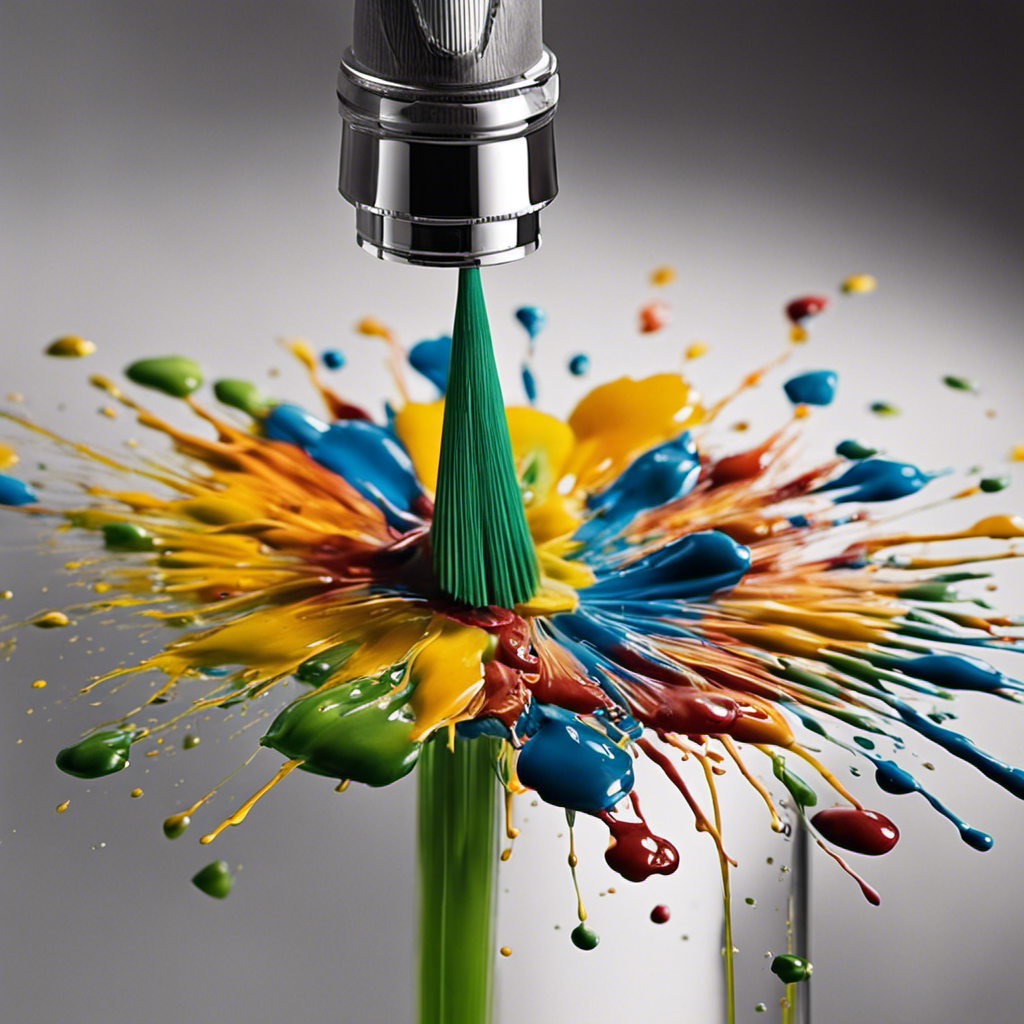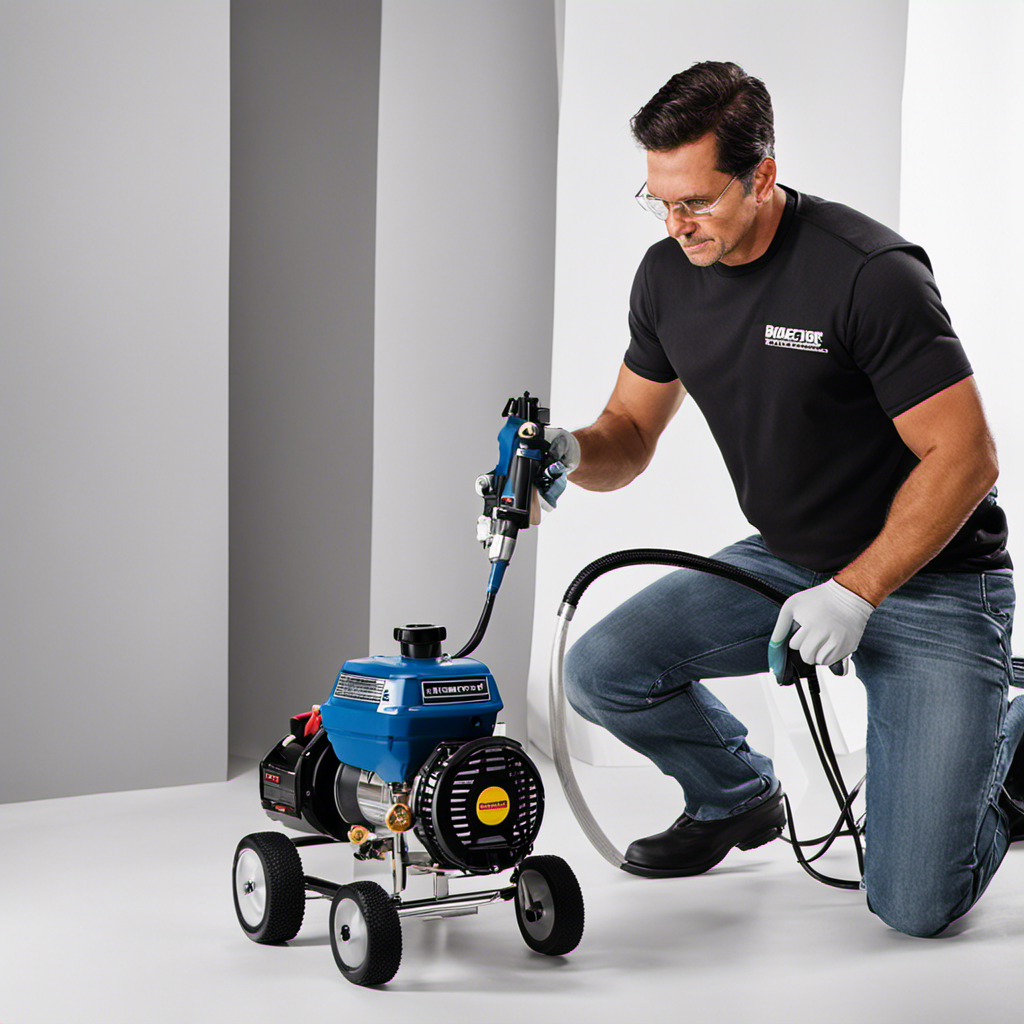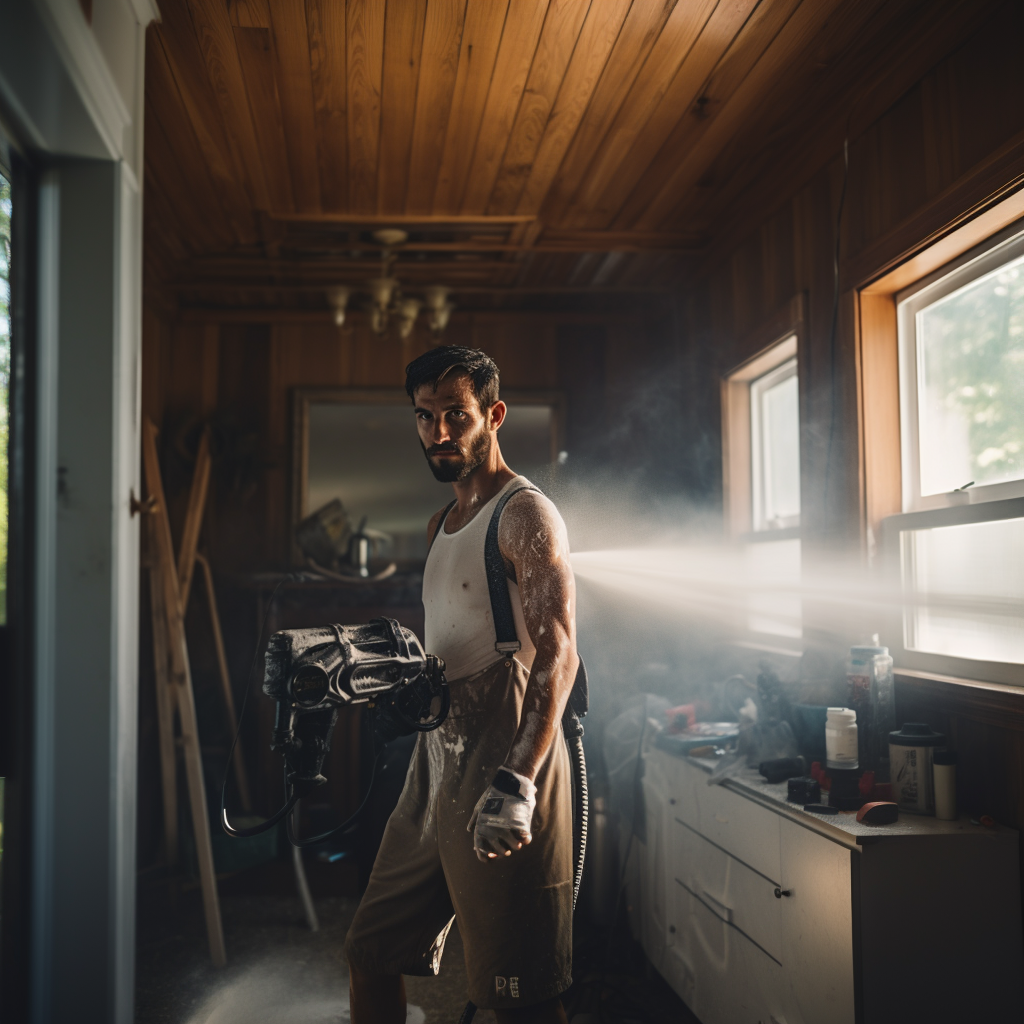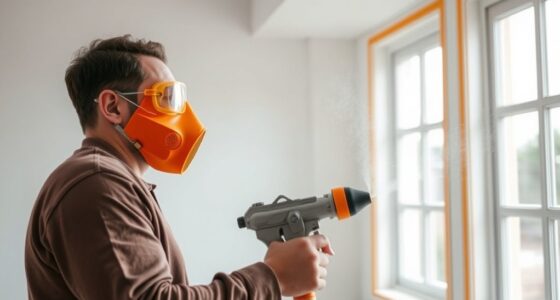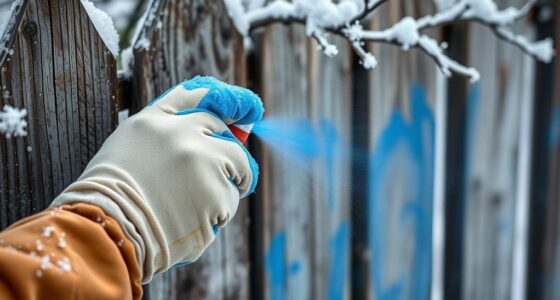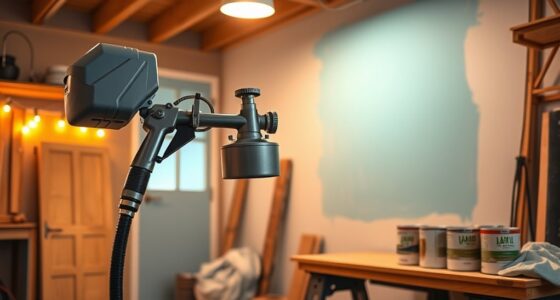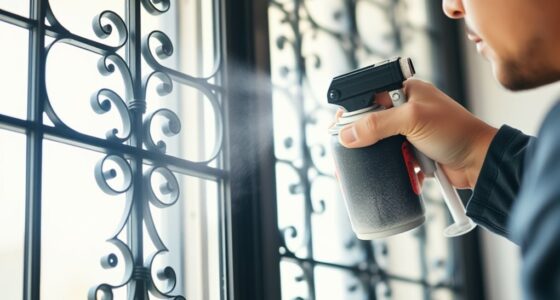Keeping an airless sprayer in excellent condition can be quite difficult, especially when it comes to removing leftover oil paint. Nonetheless, this step is crucial to guaranteeing top-notch performance and a longer lifespan.
By following the manufacturer’s instructions and donning the necessary protective gear, one can disassemble and meticulously clean every component of the sprayer. Through the use of recommended solvents and cleaners, those hard-to-reach areas and crevices can be thoroughly cleansed, resulting in a sparkling finish.
With water, paint residues can be effectively flushed out, and the sprayer can be carefully reassembled. Testing and troubleshooting are essential to guarantee smooth performance, and proper waste disposal and regular maintenance are crucial for environmental preservation.
Key Takeaways
- Regular maintenance and cleaning techniques are essential for optimal performance and longevity of an airless sprayer.
- Disassembling and cleaning each part of the sprayer is necessary to ensure its excellent condition.
- Following manufacturers’ instructions and using appropriate cleaning solutions maximize the sprayer’s lifespan and performance.
- Proper waste disposal and adherence to regulations are crucial to prevent environmental damage and protect water sources.
Importance of Regular Cleaning for Oil Paint in Airless Sprayer
Regular cleaning of an airless sprayer is crucial for maintaining optimal performance and preventing clogs when using oil paint. The importance of regular maintenance cannot be overstated, as it ensures that the sprayer functions efficiently and prolongs its lifespan.
During the cleaning process, it is essential to take safety precautions to protect oneself. Wearing gloves and protective eyewear is necessary to prevent any potential harm from the cleaning solutions or paint residues. By following these safety measures, one can clean the sprayer effectively without compromising their well-being.
Regular cleaning not only prevents clogs, but it also ensures that the sprayer operates smoothly and delivers consistent results. It is a necessary step in maintaining the sprayer’s efficiency and ensuring that it remains in excellent condition for future use.
Preparing the Work Area for Effective Cleaning
To ensure a smooth cleaning process, the user should organize their work area and prioritize proper ventilation. This includes clearing clutter and creating enough space to move around comfortably.
Opening windows or using fans to ensure fresh air circulation is crucial for protecting the user’s health and preventing fume buildup in the work area.
Additionally, it is important to take safety precautions such as wearing gloves and protective eyewear while cleaning.
Disassembling and Cleaning the Sprayer Components
After removing the nozzle and tip guard, the user should carefully disassemble the remaining parts of the sprayer for thorough cleaning. Disassembling techniques are crucial to ensure all components are properly cleaned.
Following safety precautions, such as wearing gloves and protective eyewear, is essential during this process. The user should refer to the manufacturer’s instructions for any additional parts that need to be disassembled.
It is important to remove any leftover paint residue from each disassembled component. Using a clean, lint-free cloth, the user should wipe away excess paint, paying attention to hard-to-reach areas and crevices. For stubborn paint, a soft-bristle brush can be used.
Thorough cleaning prevents clogs and maintains the sprayer’s efficiency. Safety precautions, such as wearing protective gloves and goggles, should also be followed when using solvents or cleaners.
Thoroughly Cleaning Hard-to-Reach Areas and Crevices
Using a soft-bristle brush and a clean, lint-free cloth, you can effectively clean those hard-to-reach areas and crevices of the sprayer. Thoroughly cleaning these areas is essential for maintaining the sprayer’s performance and preventing clogs.
Here are some effective cleaning techniques to ensure proper maintenance:
- Gently scrub the hard-to-reach areas and crevices with a soft-bristle brush.
- Use a clean, lint-free cloth to wipe away any excess paint or residue.
- Pay close attention to corners, edges, and tight spaces to remove any built-up debris.
- Consider using a small, angled brush or cotton swabs to reach into the smallest crevices.
Achieving a Sparkling Finish With Solvents or Cleaners
They can achieve a sparkling finish on the sprayer by utilizing solvents or cleaners recommended by the manufacturer.
When it comes to cleaning techniques for oil paint in an airless sprayer, safety precautions should always be taken into consideration. It is important to wear protective gloves and goggles to ensure personal safety. Additionally, proper ventilation in the cleaning area is crucial to prevent the buildup of harmful fumes.
Following the manufacturer’s instructions is key to using the correct solvents or cleaners for the job. By carefully selecting the appropriate cleaning solution, users can effectively remove paint residue and achieve a pristine finish on the sprayer.
Taking these safety precautions and using the right cleaning techniques will not only extend the lifespan of the sprayer but also ensure optimal performance.
Maintaining Filters and Nozzles for Optimal Performance
To ensure optimal performance, regularly inspecting and maintaining the filters and nozzles of the sprayer is essential. Proper maintenance of these components is crucial for maintaining the spray tip and troubleshooting clogs. Here are some key points to consider:
- Inspect filters and nozzles regularly: Regular inspection allows you to identify any issues or clogs before they become major problems.
- Clean filters and nozzles thoroughly: Use a suitable cleaning solution and a soft brush to remove any paint residue or debris from these components.
- Replace damaged or worn-out filters and nozzles: If you notice any cracks, breaks, or signs of wear, it’s important to replace these parts to maintain optimal performance.
- Follow manufacturer’s guidelines: Always refer to the manufacturer’s instructions for specific maintenance procedures and recommendations for maintaining the spray tip and troubleshooting clogs.
Flushing Out Paint Residue With Water
After disassembling the sprayer and thoroughly cleaning each part, the user can flush out any remaining paint residue by attaching the hose and spraying water into a waste container until it runs clear.
This step is crucial to ensure that no traces of paint are left behind, which can lead to clogs and affect the sprayer’s performance.
When flushing out the paint residue, it is important to follow safety precautions such as wearing protective gloves and goggles.
Additionally, it is essential to use clean water and avoid reusing rinsing water to prevent contamination and maintain efficiency.
Proper Reassembly of the Airless Sprayer
To ensure the airless sprayer functions properly, the user must carefully reassemble all the disassembled parts, following the manufacturer’s instructions for alignment and connection. Proper reassembly is crucial for the sprayer’s performance and longevity. Here are some reassembly tips to ensure a successful and efficient process:
- Take your time: Rushing through the reassembly process can lead to mistakes and potential damage to the sprayer.
- Double-check connections: Ensure that all parts are securely fastened and properly aligned to avoid leaks or malfunctions.
- Follow the instructions: Manufacturers provide specific guidelines for reassembly. It is important to follow these instructions to ensure optimal performance.
- Avoid over-tightening: While it is important to secure connections, over-tightening can lead to damage. Use the recommended torque specifications provided by the manufacturer.
Common reassembly mistakes to avoid include incorrect alignment, loose connections, missing parts, and over-tightening. Taking the time to carefully reassemble the airless sprayer will ensure its proper functioning and longevity.
Testing and Troubleshooting for Smooth Performance
The user can ensure smooth performance of the sprayer by testing its motor, pressure gauge, and spray tip for any potential issues. Troubleshooting tips and performance testing are crucial for maintaining optimal functionality. Here are some key steps to follow:
| Troubleshooting Tips | Performance Testing |
|---|---|
| Check for motor issues | Test motor performance |
| Inspect pressure gauge | Verify pressure gauge function |
| Examine spray tip for clogs or damage | Test spray tip responsiveness |
To troubleshoot motor issues, the user should listen for any unusual sounds or vibrations and ensure that the motor is running smoothly. To test motor performance, the user can connect the sprayer to a power source and observe its operation. When inspecting the pressure gauge, the user should ensure that it is displaying accurate readings. To verify pressure gauge function, the user can compare the gauge readings with a calibrated pressure gauge. Finally, to examine the spray tip, the user should check for any clogs or damage that may affect the spray pattern. Testing spray tip responsiveness involves spraying water or paint to determine if it is flowing smoothly and evenly. By following these troubleshooting tips and conducting performance testing, the user can identify and address any potential issues, ensuring the smooth operation of the sprayer.
Waste Disposal and Maintenance Guidelines
Implementing appropriate waste disposal methods and regular maintenance maximizes the longevity and performance of the equipment.
Proper waste disposal is crucial for preventing environmental damage and protecting water sources. Compliance with waste disposal regulations is essential to minimize environmental impact and ensure the safety of drinking water sources.
In addition to waste disposal, following proper maintenance techniques is vital for optimal equipment performance. Regular cleaning, disassembling, and inspecting each part of the sprayer is necessary to maintain its excellent condition. Thoroughly cleaning the sprayer prevents clogs and maintains its efficiency.
Proper maintenance also includes inspecting and maintaining filters and nozzles for optimal performance. By implementing waste disposal regulations and following maintenance techniques, airless sprayers can continue to deliver high-quality results and last for a long time.
Frequently Asked Questions
Can I Use Alternative Solvents or Cleaners to Clean the Airless Sprayer?
Using alternative solvents or cleaners to clean the airless sprayer is not recommended. It is crucial to follow proper cleaning techniques and use compatible cleaning solutions recommended by the manufacturer.
Using incompatible solvents or cleaners can damage the equipment and affect its performance. To ensure optimal results and maintain the sprayer’s efficiency, it is best to stick to the recommended cleaning methods and solutions.
Always prioritize safety and environmental considerations when cleaning the airless sprayer.
How Often Should I Clean the Filters and Nozzles of the Airless Sprayer?
Regular maintenance is crucial for ensuring the optimal performance and longevity of an airless sprayer. Cleaning the filters and nozzles is an essential part of this maintenance routine.
To clean the filters and nozzles properly, start by disassembling the sprayer and removing these components. Rinse them with a suitable cleaning solution and use a soft brush to remove any stubborn paint residue. Allow them to dry completely before reassembling.
Following these steps will help maintain the sprayer for long-lasting use.
What Safety Precautions Should I Take When Cleaning the Airless Sprayer?
When cleaning an airless sprayer, it is important to take proper safety precautions. This includes wearing protective gloves and eyewear to prevent any harm.
Adequate ventilation in the cleaning area is also necessary to avoid inhaling harmful fumes.
Following the manufacturer’s instructions for the cleaning process is crucial to ensure safety.
Can I Reuse the Water Used for Rinsing the Sprayer?
Reusing water used for rinsing the sprayer is not recommended because it can lead to contamination and inefficiency in the cleaning process.
Proper disposal of cleaning solvents is crucial for safety and environmental reasons.
When cleaning oil paint from an airless sprayer, it is important to use compatible cleaning solutions recommended by the manufacturer.
Alternative cleaners, such as mineral spirits or paint thinner, can be used for efficient removal of paint residue.
It is always best to follow the manufacturer’s instructions for the proper cleaning process.
Are There Alternative Methods or Tools for Cleaning Oil Paint in the Airless Sprayer?
There are indeed alternative methods and cleaning tools available for efficiently removing oil paint from an airless sprayer.
One option is to use a solvent, such as mineral spirits or paint thinner, specifically designed for cleaning oil-based paints.
Additionally, there are specialized brush cleaners that can effectively remove paint residue from the sprayer.
It’s important to explore these alternative methods and tools while considering the manufacturer’s recommendations to ensure the best cleaning results for your airless sprayer.
Conclusion
In conclusion, proper cleaning of an airless sprayer is crucial for maintaining its performance and longevity, especially when using oil paint. By following the manufacturer’s instructions and wearing protective gear, one can effectively disassemble and clean each part of the sprayer, removing leftover paint residue.
Using solvents or cleaners recommended by the manufacturer ensures a thorough cleaning, while regular maintenance prevents build-up and clogs. One interesting statistic to note is that a well-maintained airless sprayer can last up to 10 years, providing reliable performance for painting projects.
Remember to always dispose of cleaning waste responsibly to protect the environment.
Franz came aboard the Paint Sprayer Zone team with a background in both journalism and home renovation. His articulate writing style, combined with a passion for DIY projects, makes him an invaluable asset. Franz has a knack for breaking down technical jargon into easy-to-understand content, ensuring that even the most novice of readers can grasp the complexities of paint sprayers.
